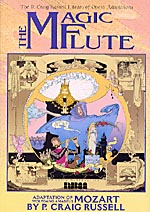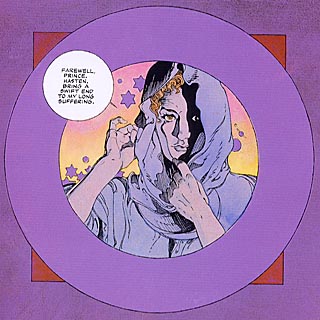 By P. Craig Russell
By P. Craig Russell
Based on the opera by Wolfgang Amadeus Mozart
144 pages, color
Published by NBM
Over a decade ago, Eclipse published The Magic Flute, P. Craig Russell’s adaptation of the opera by the same name. At the time, it must have seemed like an odd choice of comic book material to the casual observer. Now, of course, Russell is probably best known for his recent adaptation of The Ring Cycle into comics, so it makes perfect sense for NBM to bring Russell’s earlier opera adaptations back into print. Looking at this work, though, it illustrates how ahead of his times Russell was in 1990… and how some people have been consistently good for years.
When the Queen of the Night begs Prince Tamino to rescue her daughter Pamina, it seems like a simple request. As Prince Tamino and his new companion Papageno look for Pamina and her captor Sarastro, though, they find themselves in the middle of a long-simmering conflict. Of course, things could never be simple, especially when love starts to rear its head…
When adapting an opera into a comic, you’re more or less bound to the original plot. The secret, then, is to worry less about the story itself, and more about how the pacing of the story will best work on the printed page. I am admittedly unfamiliar with the original opera of The Magic Flute, so while I can’t judge it against the original, I found this really easy to follow, with the story moving at a nice brisk pace while still stopping to linger over the more interesting parts. Russell does a good job of showing both the shifting alliances of the cast as various truths are revealed, and in getting inside their heads to help the reader understand just why they make the decisions they do.
 So much of the adaptation, of course, depends on the art. It shouldn’t be a surprise to see that thirteen years ago, Russell was already a master of the sequential art form. Each page is carefully formed with two goals kept in mind: how will this page help tell the story, and how can this page be a work of art in its own right? In the end, Russell succeeds in both ways with The Magic Flute. Individual panels are lushly designed, with hints of art deco in ornate backgrounds and providing hours of entertainment in simply examining every page. At the same time, Russell doesn’t sacrifice storytelling for prettiness; each page contains just the right amount of story, with panels flowing from one into the next, and using splash pages only when the story itself demands it. Reading The Magic Flute, one can’t help but feel almost like it should be a primer for young artists on how to successfully lay out a page. A special note of attention should also go to Russell’s character designs; for a book involving noble and heroic characters, this is perhaps one of the most beautiful casts in comics, and rightly so. These really are the stuff of legends.
So much of the adaptation, of course, depends on the art. It shouldn’t be a surprise to see that thirteen years ago, Russell was already a master of the sequential art form. Each page is carefully formed with two goals kept in mind: how will this page help tell the story, and how can this page be a work of art in its own right? In the end, Russell succeeds in both ways with The Magic Flute. Individual panels are lushly designed, with hints of art deco in ornate backgrounds and providing hours of entertainment in simply examining every page. At the same time, Russell doesn’t sacrifice storytelling for prettiness; each page contains just the right amount of story, with panels flowing from one into the next, and using splash pages only when the story itself demands it. Reading The Magic Flute, one can’t help but feel almost like it should be a primer for young artists on how to successfully lay out a page. A special note of attention should also go to Russell’s character designs; for a book involving noble and heroic characters, this is perhaps one of the most beautiful casts in comics, and rightly so. These really are the stuff of legends.
Really, my only complaint with The Magic Flute is that I found myself wishing that Lovern Kindzierski (who’s colored most of Russell’s recent works) had gotten his hands on the original art and was able to update it for this nice, slick paper. The old coloring from the original version just looks a little muddy and washed out in places, but that’s a minor quibble in an otherwise outstanding looking book. The first of three volumes collecting Russell’s opera adaptations, The Magic Flute is a worthy addition to an art-lover’s library.
